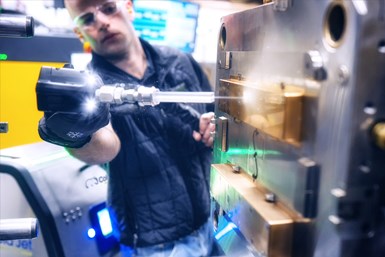Dry Ice Blasters Prove Sustainable, Non-Abrasive Mold Cleaning Action
So, what if molds could talk? Cold Jet emphasizes the importance of using dry ice cleaning via its MicroClean 2 system for a quick and effective way to cleaning molds in-situ and at operating temperature.
According to Cold Jet, it’s not uncommon for over half of all mold maintenance or corrective actions to be centered on mold cleaning. Traditional cleaning methods are also one of the four primary causes of mold wear. Choosing to clean molds with dry ice, however, Cold Jet says, is a proven, non-abrasive, quick and effective way to cleaning molds in-situ and at operating temperature. In turn, this leads to more parts, more part-to-part quality, lowers costs and ensures a safer, more sustainable environmental cleaning solution. The company demonstrates its MicroClean 2 system as an example

Cold Jet demonstrates its MicroClean 2 dry ice blaster. Photo Credit: Cold Jet LLC
Todays, dry ice blasters are smart machines incorporating a 7" LCD screen, Industry 4.0/IoT Cold Jet CONNECT capability for remote monitoring and service capabilities, programmable cleaning recipes and are capable of full automation. The PCS60, for example, gives molders the ability to adjust the process to accommodate any mold metallurgy or surface finish by selecting one of 28 different dry ice particle sizes.
Dry ice is made from reclaimed CO2, and thus essentially rid of solvents produced from man-made fluorinated gases and/or VOCs. Moreover, Cold Jet says it does not contribute to a company’s greenhouse gas (GHG) emission reporting; under EPA guidelines, CO2 was accounted for at the producer level and is not counted a second time at the point of use. Also, under current Greenhouse Gas Reporting Programs (GHGRP), dry ice blasting users are not required to report.
Related Content
-
Think Safety: Eliminate Hazards Throughout the Shop
The tooling community is taking advantage of new products for safer mold shops and molding facilities.
-
Breaking Down 3D Scanning in Moldmaking
Identifying 3D scanning requirements and implementing the appropriate technology.
-
The Ins and Outs of Hot Runner Temperature Control
A training checklist that explains the why and how of proper hot runner temperature control and system management.











